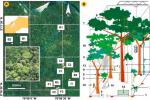Rainforest bugs finally counted
Most of animals on Earth are arthropods (insects, spiders, mites, etc.) and most of arthropod species live in tropical forests. However, after centuries of counting, biologists still do not know how many of these species live in a single rainforest. More precisely, they have not known this until now. A new, extraordinarily detailed survey of arthropods from the soil to the forest canopy in a Panama rainforest provides us with first answers.
Yves Basset from the University of South Bohemia has led a team of 102 researchers from 21 countries, named ProjectIBISCA-Panama, including Lukáš Čížek and Vojtěch Novotný from the Biology Centre ASCR. They had been sampling the rainforest from cranes, inflatable platforms, balloons, and climbing ropes for two years, then taking eight years to sort 130,000 arthropods from their samples. This data set was used to estimate that a 6,000 ha forest in Panama harbours as many as 25,000 arthropod species. The study has been published in Science on December 13, 2012.
“The arthropod diversity is overwhelming; there are twenty times more arthropod than plant species, and 83 arthropod species for every bird species”, explains Basset. “Although tropical rainforests are known to be species rich, I was surprised that it was only twice as rich as the similarly-sized Pálava Biosphere Reserve from the temperate Czech Republic, which hosts almost 12,000 arthropod species”, says Čížek, who co-authored the study.
“Another interesting discovery is that the diversity of many arthropod groups, even those not eating plants, depends on plant diversity”, says Basset. “This is convenient because plants are easier to count than arthropods. In the past we used plant diversity to estimate the total number of insect species on Earth, and this new result supports our method”, adds Novotný, another co-author.
This study further cements the position of the joint laboratory of the Biology Center ASCR and the University of South Bohemia as an international center of tropical insect research as its researchers have lead four Science and Nature papers in this field in the past decade.















